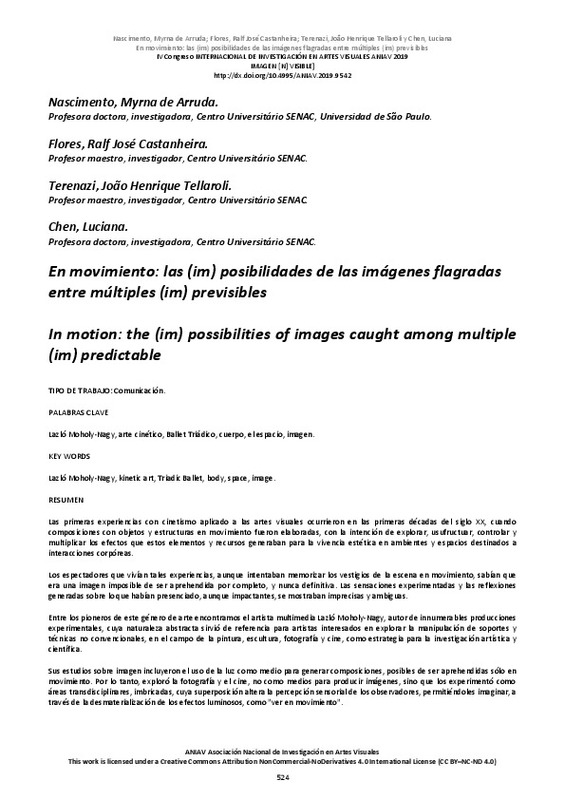|
Resumen:
|
[ES] Las primeras experiencias con cinetismo aplicado a las artes visuales ocurrieron en las primeras décadas del siglo XX, cuando
composiciones con objetos y estructuras en movimiento fueron elaboradas, con la intención ...[+]
[ES] Las primeras experiencias con cinetismo aplicado a las artes visuales ocurrieron en las primeras décadas del siglo XX, cuando
composiciones con objetos y estructuras en movimiento fueron elaboradas, con la intención de explorar, usufructuar, controlar y
multiplicar los efectos que estos elementos y recursos generaban para la vivencia estética en ambientes y espacios destinados a
interacciones corpóreas.
Los espectadores que vivían tales experiencias, aunque intentaban memorizar los vestigios de la escena en movimiento, sabían que
era una imagen imposible de ser aprehendida por completo, y nunca definitiva. Las sensaciones experimentadas y las reflexiones
generadas sobre lo que habían presenciado, aunque impactantes, se mostraban imprecisas y ambiguas.
Entre los pioneros de este género de arte encontramos el artista multimedia Lazló Moholy-Nagy, autor de innumerables producciones
experimentales, cuya naturaleza abstracta sirvió de referencia para artistas interesados en explorar la manipulación de soportes y
técnicas no convencionales, en el campo de la pintura, escultura, fotografía y cine, como estrategia para la investigación artística y
científica.
Sus estudios sobre imagen incluyeron el uso de la luz como medio para generar composiciones, posibles de ser aprehendidas sólo en
movimiento. Por lo tanto, exploró la fotografía y el cine, no como medios para producir imágenes, sino que los experimentó como
áreas transdisciplinares, imbricadas, cuya superposición altera la percepción sensorial de los observadores, permitiéndoles imaginar, a
través de la desmaterialización de los efectos luminosos, como "ver en movimiento".
Este artículo es uno de los productos del proyecto de investigación bienal (2018-2019), que estudia el Ballet Triádico de Oskar
Schlemmer, en diálogo con la producción de los demás docentes de la institución de enseñanza alemana. Discutimos inspirados en los
curadores y teóricos del arte, como los supuestos y el empirismo exploratorio de materialidades de Moholy-Nagy contaminaron a
artistas contemporáneos como el estadounidense Bill Viola.
[-]
[EN] The first experiences with kinetics applied to the visual arts occurred in the first decades of the twentieth century, when compositions
with objects and structures in motion were developed, with the intention of ...[+]
[EN] The first experiences with kinetics applied to the visual arts occurred in the first decades of the twentieth century, when compositions
with objects and structures in motion were developed, with the intention of exploring, usufruct, control and multiply the effects that
these elements and resources generated for the aesthetic experience in environments and spaces destined for corporeal interactions.
The spectators who lived such experiences, although tried to memorize the vestiges of the scene in movement, knew that it was an
image impossible to be apprehended completely, and never definitive. The sensations experienced and the reflections generated on
what they had witnessed, although shocking, were imprecise and ambiguous.
Among the pioneers of this genre of art is the multimedia artist Lazló Moholy-Nagy, author of innumerable experimental productions,
whose abstract nature served as a reference for artists interested in exploring the manipulation of non-conventional media and
techniques in the field of painting, sculpture, photography and cinema, as a strategy for artistic and scientific research.
His studies on image included the use of light to generate compositions, possible to be apprehended only in movement. Therefore, he
explored photography and cinema, not as means to produce images, but experienced them as transdisciplinary, imbricated areas,
whose superposition alters the sensory perception of observers, allowing them to imagine, through the dematerialization of light
effects, like "see in movement".
This article is one of the products of the biennial research project (2018-2019), which studies the Oskar Schlemmer Triadic Ballet, in
dialogue with the production of the other teachers of the German teaching institution. We discussed inspired by art curators and
theorists, how the assumptions and exploratory empiricism of Moholy-Nagy materiality contaminated contemporary artists such as
the American Bill Viola.
[-]
|








